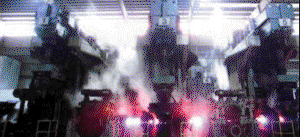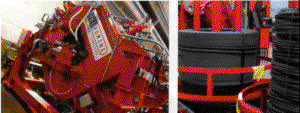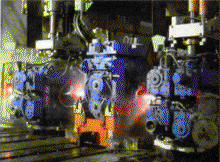БИБЛИОТЕКА по теме «Исcледование работоспособного состояния привода»

|
|
|
|
БИБЛИОТЕКА по теме «Исcледование работоспособного состояния привода» |
|
|
The continuous billet caster is designed for high-speed casting and long-sequence casting operations. All upgrading possibilities are included in the planning stage to enable, for example, ladle- shroud casting, automatic feeding of casting powder and the installation of an automatic nozzle exchanger.
Special solutions are also employed, including the Dynaflex hydraulic-oscillation system (for high-precision oscillation, online adjustment of stroke and frequency, and inverse oscillation) (Fig. 1), Diamold high-speed casting technology (characterised by minimum mould-friction forces and high heat-transfer rates) (Fig. 2), and the Dynashell secondary cooling model (for optimised strand shell solidification on the basis of specialised process models as well as for soft reduction applications).

Figure 1 – 2
Figure 3
An optional hot-charging system directly connects the run-out area of the caster and the reheating furnace of the rolling mill which saves energy and reduces intermediate storage requirements.
Complete mill packages comprising all mechanical, electrical and automation components, are provided from a single source. The mills are designed for fast and easy pre-settings of the rolling parameters and for minimised pass and stand modifications when a product size is changed. This contributes to a high degree of flexibility to changing market requirements. Rolled products are characterised by their tight and constant tolerances with low pitch variations when rolling round products.
In a typical mill design the bar line and coiling line are installed in the same bay and the rolled coils and bars are stored in a second bay. The latest rolling mill equipment and technologies are available, including a billet welding machine, automatic cascaded-speed control, cobble detection, automatic mill monitoring and billet tracking to ensure a high degree of efficiency and to reduce the risk of human errors.
To date, Siemens VAI has supplied more than 400 rolling mills. A particular highlight of the company's rolling mill equipment is its well established 'Red Ring' rolling stand of which over 4000 units have been supplied worldwide (Fig. 3). The actual number of stands required depends on the billet size in relationship to the final product dimensions.
Typically, 130xl30mm or 150xl50mm billets are rolled to produce rebars (8 to 40mm), rounds (10 to 40mm) and sections. According to the final application, a mill train will consist of 18 to 22 stands in addition to the wire rod block.
In Endless Rolling Technology (ERT) lines successive billets are welded end to end by a flash butt welder before they enter the rolling mill so that an endless rolling process takes place. With the application of a special process control system even the rolled welded joint gives a saleable product. Endless billet welding contributes to numerous operational and product benefits. These include an improved product yield (as a result of fewer nose crops and reduced end trimming of the coils), a reduction in the number of cobbles, an increased output (due to a reduction of the time lost to billet gaps), improved product quality (due to stable process conditions) and the possibility to produce flexible coil lengths and weights since the endless billet is cut according to the desired coil weight (Fig. 4).
Bar cutting is performed with a flying dividing shear, and wire rod and rebar-in-coil cutting is carried out using a reform tub shear. Control of the shear cutting process and the coil weight selection is performed automatically by a system which considers elapsed time, rod unit weight and rolling speed. A coil weight accuracy of ±25kg is achieved. Burr removal takes place in a separate deburring machine that employs rotary cutters for improved cutting and a prolonged tool life.
The latest installation of an endless rolling line was at Ovako (former Fundia), Finland, which was commissioned in January 2006. Up to eight hours of uninterrupted operations where achieved in this highly reliable production line.
In Siemens VAI's recently developed bar-spooling process round, flat, square or hexagon bar is wound under tension in a twist-free manner onto a vertical rotating mandrel into a compact coil with a high coiling density. A moveable ring distributor spools the bar onto the mandrel in orderly, highly compact adjacent rings. Because the bar is always under tension during the spooling process, the coil rings are in perfect alignment, even at high coiling speeds and with small bar diameters. With the described solution the following advantages result:
• customized coil weights (between 1500 and 5000 kg);
Figure 9 illustrates the high degree of compactness of the spooled coils (left) in comparison with the random, disorderly coiling of the wire-rod-type coils. Even with a weight of 2.9t the spooled coil is considerably smaller in size compared with the 1.5t wire-rod-type coil.)
Figure 4 - 5
Figure 6
In the area of electrical equipment and systems, a modular Simavert Masterdrive voltage source link converter system is used for motor control. This system is especially suitable for material-linked multi-motor drives, which have to be operated at extremely accurate speeds. To ensure high efficiency and high dynamics, the Simavert Masterdrive units are equipped with low-loss and fast-switching-power IGBTs (insulated gate bipolar transistors).
The automation systems regulate the complete rolling mill, from the hot-charging table to the handling of coils and bars. The Level I Automation System includes set-point setting, minimum tension control, loop control, initiation of loop pusher, shear control (cropping, chopping, sample cutting and dividing functions) and sequence control for the roller table, pinch rolls and material tracking.
• higher coiling speeds (up to 35m/s) in comparison with conventional Garret coiling (18-20m/s);
• facilitated coil processing and easier unwinding thanks to twist-free coils;
• coiling of an increased range of bar thickness and steel grades possible;
• simplified transportation logistics and reduced storage-space requirements;
• the possibility to roll larger billets, ideally complimenting endless rolling
technology.
Special sizing technologies were developed for SBQ (Special Bar Quality) steel grades as required for the automotive and other mechanical-precision industries. This was in response to the increasing market trend for good surface finishing, close-tolerance product dimensions and improved metallurgical and mechanical properties. The 2-Roll Multigroove process now accounts for more than 60% of Siemens VAI sizing installations. It provides major advantages with respect to product tolerances, operation flexibility, quick and precise settings, free sizing capability and a high throughput capacity. As an example, this sizing technology wasSpecial sizing technologies were developed for SBQ (Special Bar Quality) steel grades as required for the automotive and other mechanical-precision industries. This was in response to the increasing market trend for good surface finishing, close-tolerance product dimensions and improved metallurgical and mechanical properties. The 2-Roll Multigroove process now accounts for more than 60% of Siemens VAI sizing installations. It provides major advantages with respect to product tolerances, operation flexibility, quick and precise settings, free sizing capability and a high throughput capacity. As an example, this sizing technology was installed at Shijiazhuang Iron & Steel Co, China (Fig 10). A round-shape rod of 14mm was rolled at 18m/s. While the guaranteed dimensional tolerance was V4 DIN (German Industrial Standard), the tolerance actually obtained was better than V8 DIN.

